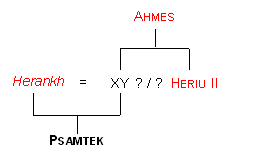
Psamtek

Psamtek1, god's father, beloved of the god, sm-priest, prophet of Ptah, priest of the temples of Memphis, High Priest of Letopolis, prophet of Nefertem, assistant, scribe of Ptah and Arsinoe2, probably to be identified with Psamtek, prophet of Nefertem, protector of the two lands, prophet of Osiris the great god, lord of Rosetau, prophet of Ptah, priest of the gods of the temple of Memphis3, grandson of Ahmes High Priest of Letopolis4, probably son of Heriu II, High Priest of Letopolis5, by Herankh6; probably born before 1757; chronology otherwise unknown.
[1] PP IX 5374. Gr: Psammetichos. W. Spiegelberg, RT 30 (1908) 144, 154, suggested Psamtek was an alternate name of Heriu III, pprobably because both were named as sons of Ahmes and as HPL, and they were not named together on any document. On the other hand, E. A. Otto, ZÄS 81 (1956) 109, 110 n. 3, thinks it more likely they are separate individuals. J. Quaegebeur, JNES 30 (1971) 239, 266, says that both propositions are difficult to argue for.
In my opinion there is no sensible reason to suppose their identity. No text gives one name as an alternate for the other. In particular, if the proposed identification of Psamtek (PP IX 5374) with Psamtek (PP IX 5877) is correct, we possess funerary material for both Psamtek (Book of the Dead: Leyden T17) and Heriu III (funerary stele Louvre C124), neither of which gives the other name. Ý
[2] Louvre N427a. Ý
[3] PP IX 5877. This priest is named on a statue Turin 1875, which calls him son of Herankh, and a papyrus Leyden T17. See J. Quaegebeur, JNES 30 (1971) 239, 254 n. 89, H. de Meulenaere reported in M. S. H. G. Heerma van Voss, Kunst voor de Eeuwigheid no 14. Against the identification one might argue that the title of High Priest of Letopolis should have been present in his funerary apparatus; indeed, de Meulenaere's reasoning for ascribing Leyden T17 to the Psamtek of Turin 1875, let alone Louvre N427a, is completely unclear from the very brief description of this papyrus. Ý
[4] Louvre N427a. This offering-table does not explicitly identify Ahmes as a High Priest of Letopolis, but names him as the father of Heriu, High Priest of Letopolis, by Tanetamun. The latter can only be Heriu II, hence the identification of Psamtek's grandfather with Ahmes High Priest of Letopolis is certain. Ý
[5] Father not named on Louvre N427a, Turin 1875 or Leyden T17. However, since Heriu II is named on Louvre N427a, since Psamtek's mother is named there as Herankh, and since at least one son of Heriu II, Heriu III, certainly became High Priest of Letopolis, the identity seems virtually certain, even though the name "Herankh" is very common. Ý
[6] Louvre N427a, Turin 1870. For the argument for identifying his mother Herankh with Herankh wife of Heriu II see above. Ý
[7] The argument for this is circumstantial. Heriu III was born in 174, and was only 10 years old when his father Heriu II died. The High Priest of Letopolis was preferably an adult. Hence an elder brother, if available, would be preferred. Ý
Update Notes:
8 November 2002: Created page
Website © Chris Bennett, 2001, 2002 -- All rights reserved